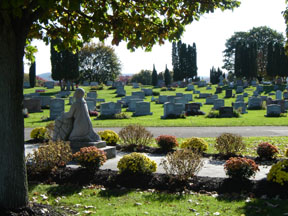St. Bonaventure Cemetery

Consecration of the Cemetery
The cemetery was consecrated by "our
amiable and beloved
Bishop Timon,"
which is very unusual for a cemetery. Bishop Timon was present during the
Jubilee, he lectured on "All Souls evening, [Nov. 1858]" and, "administered
Confirmation...to a goodly number of adults." The consecration began at
10:30am.
"The Rt. Rev. Bishop, dressed with cope and mitre, stood before a large cross,
erected about the centre of the cemetery, and after having read appropriate
prayers and the Litany of the Saints, he walked all around the enclosure,
sprinkling the ground; the choir singing in the meantime the anthem, Asperges ,
and the while of the Miserere...At last the Celebrant Prelate returning to the
larger cross in the centre, did there in like manner, though with more solemn
rite, and accomplished the Consecration."
"The conclusion of the Solemnity was the Papal Benediction which our High Priest
and Bishop procured personally from the most High Pontiff for his flock...
Nearest to the Church were the priest-brothers and sisters who serve it most
intimately. Surrounding them were the faithful. At a distance and
outside of the consecrated ground were those who would have no part with the
living church-those who chose the potters field as their way of life."

The Cemetery Today
In 2003 the St. Bonaventure Cemetery came under the rules and regulations of The New York State Cemetery Board, and is officially known as St. Bonaventure Cemetery Incorporated. The cemetery was not previously under New York State regulation because of its close affiliation with St. Bonaventure University. However, when the state realized how large the cemetery was, no longer a small churchyard cemetery, it stepped in. In addition, the cemetery is now open to all people for burial; the old tradition of needing a letter of good standing from the deceased's parish is no longer in practice. This tradition gradually lost popularity over time as the cemetery, and society, evolved. Another change made is the requirement for granite stones. Older stones are often made of marble and sandstone, which weather and age poorly; granite, however, is practically immune to the elements and time. St. Bonaventure Cemetery's rules and regulations now require a granite stone.
St. Bonaventure Cemetery was not the first cemetery for the St. Bonaventure parish and people of the area. A smaller cemetery located on Main Street, named St. Nicholas Cemetery, was the original site. But due to the growing population and the building of roads and the railroad the site was moved.
In the early 19th century St. Nicholas Cemetery, built in 1854, was one of only a few Catholic cemeteries in the region, and thus grew very fast. In 1858 the St. Bonaventure Cemetery was founded near the St. Elizabeth Motherhouse, and later grew into the cemetery as it is today. The cemetery has purchased land from various surrounding family-run farms to increase its acreage.
A partial listing of the graves in the cemetery may be found at the Painted Hills web site.
In the spring of 2014, the Digitial History 419 class began an exciting new chapter for the St. Bonaventure Cemetery. The goal is to experience the lives of those buried at the cemetery in a new way by taking a walk through the places the individual lived, learned, taught at and impacted. Learn more about it here.
Thanks to Bernie Vossler of the SBU cemetery for permitting access to the records and documents maintained by the cemetery for the information on this page.
Last updated: 6 February 2015